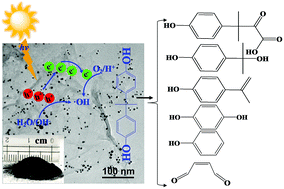当前位置:
X-MOL 学术
›
Photochem. Photobiol. Sci.
›
论文详情
Our official English website, www.x-mol.net, welcomes your
feedback! (Note: you will need to create a separate account there.)
Plasmonic photocatalysis: complete degradation of bisphenol A by a gold nanoparticle–reduced graphene oxide composite under visible light†
Photochemical & Photobiological Sciences ( IF 2.7 ) Pub Date : 2018-04-10 00:00:00 , DOI: 10.1039/c8pp00012c Haydar Ali 1, 2, 3, 4 , Nikhil R. Jana 1, 2, 3, 4
Photochemical & Photobiological Sciences ( IF 2.7 ) Pub Date : 2018-04-10 00:00:00 , DOI: 10.1039/c8pp00012c Haydar Ali 1, 2, 3, 4 , Nikhil R. Jana 1, 2, 3, 4
Affiliation

|
Bisphenol A is a well-known endocrine disruptor that comes from plastic/epoxy resin-based consumer products, pollutes our environment and is responsible for various human diseases. Thus, its removal from water/food/the environment is becoming a challenging issue. Here we report the visible light photocatalytic degradation of bisphenol A using a gold nanoparticle based composite with reduced graphene oxide. The nanocomposite captures visible light and produces hydroxyl radicals that oxidize bisphenol A into smaller organic fragments such as phenol derivatives and aliphatic aldehydes/ketones. The composition of the nanocomposite has been optimized for most efficient degradation of bisphenol A under visible light and the approach may be extended for the sunlight-based removal of bisphenol A from water/food/the environment.
中文翻译:

等离子体光催化:金纳米粒子还原的氧化石墨烯复合物在可见光下完全降解双酚A †
双酚A是一种众所周知的内分泌干扰物,来自塑料/环氧树脂基消费产品,污染了我们的环境,并导致各种人类疾病。因此,将其从水/食物/环境中去除正成为一个具有挑战性的问题。在这里,我们报告了使用金纳米颗粒基复合材料与氧化石墨烯还原的双酚A的可见光光催化降解。纳米复合材料捕获可见光并产生羟基自由基,该自由基将双酚A氧化为较小的有机片段,例如酚衍生物和脂族醛/酮。纳米复合材料的组成已针对可见光下双酚A的最有效降解进行了优化,该方法可扩展到基于阳光的水/食品/环境中双酚A的去除。
更新日期:2018-04-10
中文翻译:

等离子体光催化:金纳米粒子还原的氧化石墨烯复合物在可见光下完全降解双酚A †
双酚A是一种众所周知的内分泌干扰物,来自塑料/环氧树脂基消费产品,污染了我们的环境,并导致各种人类疾病。因此,将其从水/食物/环境中去除正成为一个具有挑战性的问题。在这里,我们报告了使用金纳米颗粒基复合材料与氧化石墨烯还原的双酚A的可见光光催化降解。纳米复合材料捕获可见光并产生羟基自由基,该自由基将双酚A氧化为较小的有机片段,例如酚衍生物和脂族醛/酮。纳米复合材料的组成已针对可见光下双酚A的最有效降解进行了优化,该方法可扩展到基于阳光的水/食品/环境中双酚A的去除。











































 京公网安备 11010802027423号
京公网安备 11010802027423号